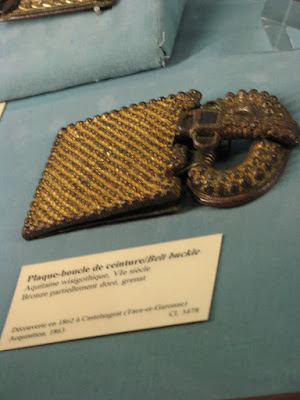It is the same plate that I described in my last post which described my morning at the Louvre.
Here is it again:

It is pretty, but I am predisposed without even hearing his arguments to not believe this scholar's opinion. I have a hard time believing that something made out of serpentine, which can contain high amounts of asbestos, would be one of the most sought after holy artifacts of all time.
However, since we have a digital picture frame gracing our mantel, I will from now on say, "oooh look, the Holy Grail!" whenever this photo cycles through the rotation.
-
Last year at this time I wished everyone a Happy Feast of the Holy Circumcision noting that the Julian calendar was designed to have the beginning of the calendar year coincide with the naming ceremony of Jesus Christ as well as celebrating the day of his bris. I had not touched on the idea that his severed foreskin became a holy relic.
Today I discovered that last year Slate magazine covered the disappearance of the Holy Prepuce in Calcata, Italy. In a sidebar Slate claims that during the Middle Ages that there were up to eighteen different purported Holy Foreskins.
However, the one from Calcata was "according to legend" given by Charlemagne to Pope Leo III on Christmas Day in the year 800, the same day he was crowned emperor.
Legend has it that Charlemagne had received the artifact from angels as he was praying at the Church of the Holy Sepulchre in Jerusalem.
I do not think Charlemagne ever traveled to Palestine. At least, I have not seen that in any of the biographies and histories I have read about him.
So once again, I am skeptical.
There's also the bizarre belief propounded in the seventeenth century by Leo Allatius that when Jesus ascended into the heavens that his foreskin likewise went skyward. Only it then expanded and became the rings of Saturn.
Sure, that is likely.
Or possibly that instead of being in any of the various reliquaries, that the foreskin of Christ was actually the bridal ring wore by Catherine of Siena.
In order to believe that possibility, one has to forgo all logic and depend heavily on mysticism.
And now to the What The...part of my post. As I was websurfing today to find these various links and anecdotes, I came across something I had been blissfully unaware. It is disturbing.
It involves a religious practice after the bris.
I had not given the subject much thought and then when I put in the search term for bris in Wikipedia I was shocked when in that article it mentioned metzitzah b'peh. It is how a mohel treats the surgical site.
"To promote healing" oral suction is applied to cleanse the area of blood.
Eww.
Ewwwwwwwwww.
That is wrong on so many levels. The question becomes, how many levels can I identify?
Before I begin, I must admit that my day job is as a Clinical Laboratory Scientist so bear with me as I don my cyber lab coat and try to walk non-scientists through my reasoning.
First off, saliva does not include any blood clotting agents. Salivary amylase helps to begin the digestion process, but it will not promote coagulation.
Second, mouths and saliva are not sterile.
Some people harbor small amounts of pathogens such as Staphylococcus aureus or Haemophilus influenzae as part of their normal flora, and since newborns are without a developed immune system they are especially vulnerable to infection.
Any bacteria can become pathogenic if given the opportunity.
I do not care if modern day mohels use mouthwash before they apply their mouths to a boy's genitals. It is not a sterile procedure.
Lest you think that I am making this up or think that I am being exceedingly gullible in relying upon Wikipedia as my source of information, I did some further digging. Here is an article from the New York Times about a mohel who had performed a circumcision on a boy who later died from herpes he had contracted due to the oral suctioning. It is dated August 2005.
Oy vey.
And then if you want further confirmation, here is an article from the journal Pediatrics about the dangers of transmitting herpes from that cultural practice.
I honestly do not have the heart to read that PDF article, but I offer it as evidence that this is not an Urban Legend. It is real and it is wrong.
There are many religious practices that at the time they were first introduced had rationales that might not have been readily apparent at the time. Such as the prohibition of eating pork. We know it was due to the parasite Trichinella spiralis which causes Trichinosis.
I cannot come up with any justification for applying one's mouth to a bleeding sexual member.
It is just sick and wrong. I do not care about its lengthy and historical tradition. It is abuse.
If I were to witness a physician perform a circumcision in my hospital and then orally suction the surgical site, I would - as a mandated reporter - be required by law to report them to legal authorities for committing sexual abuse.
For anyone who does not consider this practice on neonates as being abusive, you must also consider that circumcisions are also performed on boys and men who convert to Judaism. Imagine a mohel performing that ritual practice on an adolescent or adult male. Would there be any question of it being sexual abuse in your mind?
I am just seriously creeped out by this practice - and well - I had to share.
And on that strange note, Happy New Year everyone!
Anyone want to chime in with their thoughts on holy relics and/or the post-surgical practices of mohels?
Linda





















































